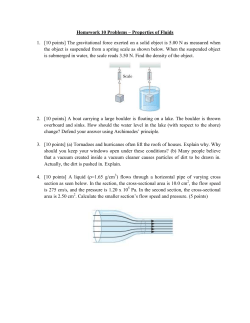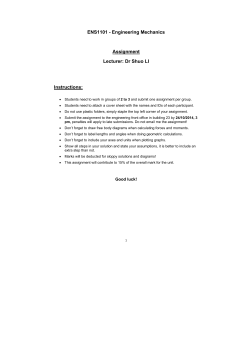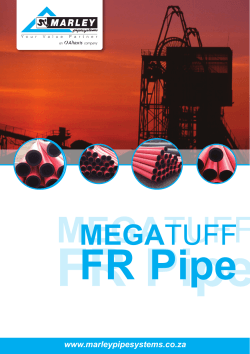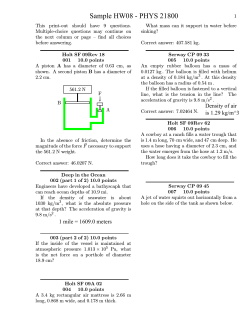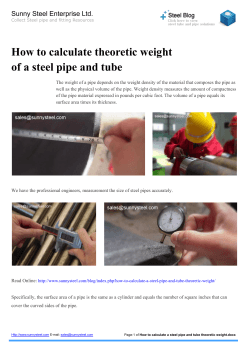
Pipe Bending By High Frequency Induction Heating
Optimum Design of Pipe Bending Based on HighFrequency Induction Heating Using Dynamic Reverse Moment Pipe bending by high-frequency local induction heating is an advanced technique used to bend pipes having a small bending radius and a large diameter. Although pipe bending is a widely used engineering process, the optimum process parameters are decided on the basis of a trial and error method by highly experienced field engineers. Hence, it is necessary to develop an integrated methodology for the optimum design of the pipe bending process. During hot-pipe bending using induction heating, the thickness of the outer wall of the pipe decreases because of tensile stress, but the thickness is not allowed to decrease by more than 12.5%. The use of the DOE method and a dynamic reverse moment is proposed for maintaining the thickness reduction ratio to within 12.5%, when D/t is high. The results of the proposed approach are found to be in good agreement with those of FEA. Manuscript received: February 9, 2011 / Accepted: June 7, 2011 NOMENCLATURE D = outer diameter of pipe (mm) Mb = bending moment (kN · m) Mc = reverse moment (kN · m) R = bending radius (mm) r = pipe radius (mm) rm = average radius of pipe (mm) t = pipe thickness (mm) t0 = initial thickness of pipe (mm) β = angle of neutral axis (o) ∆R = distance between neutral axis and x-axis ρ = radius of curvature 1. Introduction Pipe bending process by high-frequency local induction heating is commonly used for pipes having a small bending radius and a large diameter, without the need for a mold. This technique has been used widely in power plant and shipbuilding plant.1-3 The aforementioned technique offers several advantages over conventional processes that involve molding and welding, such as low cost, high productivity, and affords products with good material properties.1,4 Bending process are studied for various materials.5 However, pipe bending is a complex process since it involves thermal bending and high-frequency local induction heating. During pipe bending, the outer wall of the pipe is thinned owing to tensile stress, while the inner well is thickened because of compressive stress. In engineering design, the thinning of the pipe wall is not allowed to exceed 12.5% because the products of pipe bending are generally used to transport fluids with high temperature and pressure, and products in which the wall thickness decreases beyond the aforementioned limit would be unsuitable for this purpose.6 W. Zutang et al.6 derived a formula for a dynamic reverse moment to be used when bending pipes with a small bending radius. Z. Hu et al.1,3 proposed a method for determining the wall-thickness reduction on the basis of the bending angle, bending force, reverse moment, and spring-back angle, by using computer simulations. Kim et al.7 investigated the effect of the reverse moment and temperature gradient on wall-thickness reduction, and applied the reverse moment to an actual pipe-bending process. The ratio of the bending radius of a pipe (R) to its outer diameter (D) is given by DR. In the case of a pipe with a small 1052 / DECEMBER 2011 INTERNATIONAL JOURNAL OF PRECISION ENGINEERING AND MANUFACTURING Vol. 12, No. 6 dl' dl rm sinβ dϕ ρ (ϕ ) Fig. 1 Model of the hot pipe bending process using induction heating θ βr m ∆R y dϕ' Fig. 3 Spring-back deformation t 2.2 Reverse Moment1 The position of the neutral axis relative to the reverse moment is shown in Fig. 2. The neutral axis is shifted outside the bending area by the reverse moment, and the bending area under the tensile stress is decreased. This, in turn, brings about a decrease in the thickness reduction ratio. The reverse moment, Mc, satisfying the design conditions for pipe bending is given by Eq. (2). R O Fig. 2 Position of neutral axis with respect to reverse moment bending radius which is less than 1.5 DR and a relatively large outer-diameter-to-thickness ratio (D/t), the criterion that the wallthickness reduction should not exceed 12.5% is not satisfied, and ovality occurs at the bending area. In this study, the effect of the design factors used in the pipe bending process on an objective function are analyzed by using the DOE (design of experiment) method. An optimum pipe-bending process with minimum wall-thickness reduction is designed on the basis of the analysis results. Then, a reverse moment is applied to the area in which the wall-thickness reduction is more than 12.5%. (π − 2 β ) cos β + 2sin β R M c = 2σ s t0 rm2 (π − 2 β ) + 2( R / rm + cos β ) rm (π − 2β ) + sin 2β −2sin β − 4( R / rm + cos β ) 2.3 Spring-back In the pipe-bending process, which has elasto-plastic behavior, spring-back deformation occurs after unloading the bent pipe. Deformation caused by spring-back is shown in Fig. 3, and the equation for predicting the spring-back angle is given by Eq. (3).3 d (∆ϕ ') = dϕ − dϕ ' 2. Theoretical Analysis of Pipe Bending Pipe bending based on high-frequency local induction heating involves (1) high-frequency local induction heating, (2) feeding of the pipe, and (3) clamp part. The model of the aforementioned hotpipe bending process is shown in Fig. 1. One end of the pipe is fixed with the help of a bending arm pivotable about rotation axis, and a bending force is applied to the other end by the transportation equipment. Upon induction heating, a bending moment is generated in the heating area, and the pipe is bent. Then, the pipe is cooled by spray-cooling with cooling water. 2.1 Thickness Reduction Ratio In the theoretical analysis of the hot-pipe bending process, it is assumed that the pipe material is rigid plastic and incompressible. The equation for the thickness reduction ratio when the average radius of the pipe is assumed to remain unchanged after bending is6 ∆t 1 − cos β = t0 R / rm + cos β (1) (2) (3) Here dφ and dφ' are the bend angle of the infinitesimal segmental pipe before and after spring-back, respectively. The strain of the bent outside for spring-back is given by Eqs. (4) and (5).3 εz = ' dl '− dl [ ρ (ϕ ) + rm (1 − sin β )]dϕ − ( R + rm ) dϕ = dl ( R + rm )dϕ (4) σz kr = − m (1 − sin β ) E E (5) ' εz = ' 3. Finite Element Analysis of Hot-Pipe Bending The effect of the design factors used in hot-pipe bending on the thickness reduction ratio is investigated by the DOE method. The steps required for a robust design of pipe-bending process are decided on the basis of the FEM (finite element method) and are shown in Fig. 4.8 INTERNATIONAL JOURNAL OF PRECISION ENGINEERING AND MANUFACTURING Vol. 12, No. 6 DECEMBER 2011 / 1053 CAD Model Technological parameter Initial design Control Factor Simulation Orthogonal Array Simulation Result Control Factor 1. 2. 3. 4. 5. FEM Model Heating temperature Temperature gradient Reverse moment Feeding velocity Heating width sc it sir tec ar hac ec na m ro rfe P Orthogonal Array Calculate SN Ration, Sensitivity Robust design (a) Tensile specimen Inner Table Statistical Analysis Performance characteristics Pipe thickness reduction ratio Fig. 4 Steps in robust design of pipe-bending process, as decided by FEM 3.1 Modeling and Boundary Condition For obtaining data pertaining to the properties of the pipe material (A 106 Gr. B), a high-temperature tensile test is performed. Four test temperatures-900°C, 950°C, 1000°C, 1050°C-are employed, and at each temperature, five strain rates are used: 0.00625s-1, 0.02s-1, 0.034s-1, 0.048s-1, and 0.0625s-1. The tensile specimen, tensile tester (MTS) and the stress-strain relationship at each temperature for the abovementioned strain rates are shown in Fig. 5. Pipe models used in the actual field are shown in Fig. 6. The ratios of the radius of curvature to the outer diameter (ρ/D) are the same for all the pipe models; however, the outerdiameter-to-thickness ratio (D/t) is different in each case. The commercial code Deform 3D is used for the elasto-plastic FEM analysis. The pipe model is designed with 1/2 symmetry because the pipe must be made symmetric in the circumferential direction for reducing the analysis time. To ensure high accuracy of the analysis, the grids in the area subjected to local induction heating are made relatively dense, and the mesh number is set to 10,000 by taking into account the deformation of the pipe and computer analysis time. The FEM modeling of pipe bending is shown in Fig. 7; it is assumed that the pipe material is elasto-plastic and that the dies are rigid. The shear friction between the punch and the pipe is assumed to be of non-separate type, and there is no friction in the other parts of the model (between the guide ring and the pipe, and between the pivot and the pipe), as shown in Fig. 8. To apply the effect of local induction heating, the temperature at each node in the pipe model is changed at specific time intervals. Because of the temperature variation in the model, three zones can be identified: a preheating zone resulting from heat conduction, a deformation zone caused by local induction heating, and a cooling zone (Fig. 9). To investigate the dependence of the thickness reduction ratio on D/t, we perform finite element analysis (FEA) for three cases; the process variables used in all the cases are the same (Table 1). The change in the thickness reduction ratio with the bending angle is shown in Fig. 10. In case 1, the difference between the maximum (A) and the minimum (B) thickness reduction ratios is 3.2%; this difference is greater than that in case 2 and case 3 (1.9% and 1.4%, respectively). When the thickness reduction ratio changes with the (b) MTS tensile tester (c) Stress-strain curve Fig. 5 Stress-strain relationship for different strain rates Detail A A D:168.3 t:9.3 t:7.1 Case 1. D/t : 23.7 Case 2. D/t : 18.1 t:11.0 Case 3. D/t : 15.3 Fig. 6 Pipe modeling on the basis of D/t bending angle because of the relatively large difference between the A and B values, it is difficult to ensure that the wall-thickness reduction is less than 12.5%, and hence, a reverse moment must be applied. 1054 / DECEMBER 2011 INTERNATIONAL JOURNAL OF PRECISION ENGINEERING AND MANUFACTURING Vol. 12, No. 6 Table 2 Feeding moment and limit reverse moment decided by FEM D/t 23.7 18.1 15.3 Moment (t:7.1mm) (t:9.3mm) (t:11.0mm) Feeding moment 23.22KN·m 31.30KN·m 36.93KN·m Limit reverse moment 13.93KN·m 18.78KN·m 22.16KN·m Pipe (A106B) Pivot Limit reverse moment: 60% of the feeding moment (Rigid) Guide Ring (Rigid) Punch (Rigid) 89.1 90 Fig. 7 Modeling for pipe bending (a) Angle before spring-back (b) Angle after spring-back Fig. 11 FEA results of spring-back angle Fig. 8 Boundary conditions for pipe bending process preheating zone deformation zone Cooling zone Pipe outsied wall t V=0.5~1.5mm/s Pipe insied wall Pipe outsied wall C 1050℃ B 950℃ A 850℃ A B C 20℃ 15mm 15mm 25mm 20℃ Pipe insied wall Fig. 9 Variation in temperature with heating time at each node Table 1 Process variables for FEA R.M T.G (KN·m) (°C) Case 1~3 0 0 R.M: Reverse moment(kN·m) H.T: Heating temperature(°C) H.W: Heating width(mm) In case 1 (maximum value of D/t), where the difference between the A and B values is the largest among that in all three cases, the limit reverse moment is relatively small; hence, it is difficult to maintain the required thickness reduction ratio constant when the bending angle changes. In case 3, a reverse moment greater than that in cases 1 and 2 can be applied, and therefore, the thickness reduction ratio can be maintained constant. FEA is preformed for case 1 (D=168.3mm, t=7.11mm), where the small limit reverse moment and the large difference between A and B values makes it difficult to obtain a constant thickness reduction ratio. H.T (°C) 950 F.V (mm/min) 60 H.W (mm) 10 T.G: Temperature gradient(°C) F.V: Feeding velocity(mm/min) 3.2 Analysis of Spring-back For predicting a spring-back angle, FEA is performed using the conditions in Table 1. As shown in Fig. 11, the bending angles before and after spring-back are 90° and 89.1°, respectively. By using FEA and Eq. (3), the spring-back angle is obtained as 0.9°. Therefore, it is necessary that the bending angle is modified by considering spring-back because the acceptable tolerance of the pipe bending-angle is 90°±0.5°. 3.3 Robust Design 3.3.1 Design Variables and Control Factor Levels The model used for the robust design of hot-pipe bending is shown in Fig. 12. The objective function for the process design is that the thickness reduction ratio must not exceed 12.5%. The control factors that affect the thickness reduction ratio are heating temperature, temperature gradient, reverse moment, feeding velocity and heating width. The magnitude of the reverse moment is chosen on the basis of the theoretical analysis (Eq. (2)), and the initial values of the design factors are determined on the basis of experimental knowledge of the field (Table 3). 3.3.2 Orthogonal Array Fig. 10 Variation of thickness reduction with D/t when the outer diameter is 168.3mm The level of each control factor is set at 4 on the basis of the values listed in Table 2 (Table 4). An L16 orthogonal array that accommodates five design factors at four levels is used, and it is assumed that there is no interaction between the factors. The conditions and arrangement for each experiment are shown in Table 5. INTERNATIONAL JOURNAL OF PRECISION ENGINEERING AND MANUFACTURING Vol. 12, No. 6 Table 6 SNR for robust design NO. T.R(%) SNR 1 26.40 -28.43 2 22.82 -27.16 3 17.85 -25.03 4 14.40 -23.16 5 17.80 -25.00 6 18.47 -25.32 7 17.42 -24.82 8 19.37 -25.74 Taguchi method for 1.5D pipe bending process Heating Temperature(℃ ) Outside Heating Width (mm) t0 Feeding Temperature Velocity(mm/min) Gradient(℃) Reverse Moment(KN∙m) t Inside ◈ Design Intention : The thinning of pipe wall is not allowed to exceed 12.5% ◈ Performance characteristic : Pipe thickness reduction ratio, Smaller is better ◈ Design Target : Signal-to-Noise Ratio, Smaller is better ▪ Temperature Gradient ▪ Heating Temperature ▪ Feeding Velocity ▪ Heating Width Fig. 12 Model for robust design of hot-pipe bending Table 3 Initial design for 1.5DR pipe bending Design R.M T.G H.T F.V parameter (KN·m) (°C) (°C) (mm/min) Value 6.81 40 950 50 NO. 9 10 11 12 13 14 15 16 T.R(%) 17.92 17.99 14.68 14.85 12.78 11.87 17.53 14.50 SNR -25.06 -25.10 -23.33 -23.43 -22.13 -21.48 -24.87 -23.22 F.V -24.54 -24.59 -24.59 -24.61 0.07 5 H.W -26.04 -25.07 -23.98 -23.25 2.79 2 T.R: Thickness reduction ratio(%) SNR: Signal-to-noise ratio Table 7 SNR response Level R.M 1 -25.95 2 -25.23 3 -24.23 4 -22.93 δ 3.02 Rank 1 ◈ Control Factors : ▪ Reverse Moment DECEMBER 2011 / 1055 H.W (mm) 10 T.G -25.16 -24.77 -24.52 -23.89 1.27 4 H.T -25.08 -25.12 -24.33 -23.80 1.32 3 Main Effects Plot (data means) for SN ratios R.M T.G H.T -23 Table 4 Control factor levels Factor R.M T.G Level (KN·m) (°C) 1 4.54 20 2 6.81 40 3 9.08 60 4 11.36 80 -24 H.T (°C) 920 940 960 980 F.V (mm/min) 40 50 60 70 Table 5 Experiment arrangement (inner table L16 (45)) Factor R.M T.G H.T F.V NO. (KN·m) (°C) (°C) (mm/min) 1 4.54 20 920 40 2 4.54 40 940 50 3 4.54 60 960 60 4 4.54 80 980 70 5 6.81 20 940 60 6 6.81 40 920 70 7 6.81 60 980 40 8 6.81 80 960 50 9 9.08 20 960 70 10 9.08 40 980 60 11 9.08 60 920 50 12 9.08 80 940 40 13 11.36 20 980 50 14 11.36 40 960 40 15 11.36 60 940 70 16 11.36 80 920 60 H.W (mm) 8 10 12 14 s -25 io t a r N S f o 6.81 9.08 11.36 20 40 F.V 60 80 12 14 920 940 960 980 H.W -24 -25 -26 H.W (mm) 8 10 12 14 14 12 10 8 10 8 14 12 12 14 8 10 40 50 60 70 8 10 Signal-to-noise: Smaller is better Fig. 13 Main effects plot for SNR Because a small thickness reduction ratio is preferred for our objective function, the smaller-the-better-characteristic given by Eq. (6)9 is used: i 4.54 n a -23 e M 3.3.3 Process Design SNR = −10log10 (Σy 2 / n) -26 (6) Where n is the number of the experiments, and y is the value of the characteristic. The signal-to-noise ratio (SNR), which is calculated by using Eq. (6), increases with a decrease in the thickness reduction ratio, as is evident from the data shown in Table 6. The SNR response and main effect plot for the SNR are shown in Table 7 and Fig. 13, respectively. The control factor that has the strongest effect on the thickness reduction ratio is the reverse moment (δ=3.02, Rank 1), and the effect of the other factors is in the following order: heating width (δ=2.79, Rank 2) > heating temperature (δ=1.32, Rank 3) > temperature gradient (δ=1.27, Rank 4) > feeding velocity (δ=0.07, Rank 5). Because the neutral axis is forcibly shifted outside the pipe, the thickness reduction ratio is smaller when the reverse moment is stronger. However, when the reverse moment is stronger than the feeding moment, buckling occurs at the inner wall of the pipe, or pipe bending becomes impossible. Therefore, the reverse moment is limited to about 60% of the feeding moment in the field. Because a large heating width may result in necking, buckling and poor out-of roundness, the heating width is generally limited to a value that is twice the pipe thickness.1 A temperature gradient is created because the region under compressive stress has relatively high temperature and that under tensile stress has a low temperature; consequently, the deformation resistance in the tensile-stress region is higher than that in the compressive-stress region. Therefore, deformation of the 1056 / DECEMBER 2011 Fig. 14 Thickness reduction ratio for different bending angles when D/t is high INTERNATIONAL JOURNAL OF PRECISION ENGINEERING AND MANUFACTURING Vol. 12, No. 6 Fig. 16 Variation of thickness reduction for various reverse moments Fig. 17 Reverse moment diagram obtained from Fig. 14 Fig. 15 Pipe shape simulated on the basis of the results of design experiment outer diameter of the pipe is suppressed, and the thickness reduction ratio is decreased. The optimal values of the reverse moment (11.36kN·m), temperature gradient (80°C), heating temperature (980°C), feeding velocity (40mm/min) and heating width (14mm) are obtained on the basis of the main effects plot for the SNR. FEA is performed for the optimal process; the results of thickness reduction ratio and pipe shape are shown in Fig. 14 and Fig. 15, respectively. The average thickness reduction ratio determined by FEA, 11.65%, is less than the reduction ratios for the 16 cases in the orthogonal array. However, the reduction ratio in the specific term (about 18°) in Fig. 14 is 13.1% which is greater than the limit thickness reduction ratio, 12.5%; this trend is pronounced at a high D/t. Ovality occurs at bending angles of 23° - 78° because of the reduction in the inner diameter of the pipe. 3.4 Applying a Dynamic Reverse Moment When the thickness reduction ratio is less than 12.5%, a pipe with a high D/t is not obtained even after the process design is optimized by the DOE method, and pipe ovality occurs. A reverse moment larger than 11.36kN·m is required when the bending angle is in the range 10° - 48° because that the criterion of the limit reverse moment is not satisfied. A reverse moment smaller than 11.36kN·m is required for the bending angle range 48° - 90° Fig. 18 FEA results obtained when a dynamic reverse moment is applied because a large reverse moment may result in ovality. The change in thickness reduction with the reverse moment is shown in Fig. 16. Fig. 17 shows the dependence of the reverse moment on the bending angle for the case where the reverse moment is less than the limit thickness reduction ratio of 12.5%; the data from Fig. 16 have been used for this plot. The FEA results obtained when applying the dynamic reverse moments and the pipe shape are shown in Fig. 18 and Fig. 19, respectively. When the dynamic reverse moment is applied, the thickness reduction ratio is less than 12.5% in all angle ranges (i.e. 0°-90°), as shown in Fig. 18. Therefore, pipe ovality does not occur, as shown in Fig. 19. INTERNATIONAL JOURNAL OF PRECISION ENGINEERING AND MANUFACTURING Vol. 12, No. 6 Fig. 19 Pipe shape simulated when a dynamic reverse moment is applied Table 8 Experiment condition for pipe bending Parameters Values Parameters Material A106 Gr.B Heat width(mm) Reverse Pipe size 6” S40 moment Temperature Out diameter 168.3mm gradient Thickness (mm) 7.1mm Heat temperature D/T 23.7 Feeding velocity 90.9 (a) Angle before spring-back DECEMBER 2011 / 1057 Fig. 21 Apparatus for high frequency induction heating and dynamic reverse moment Values 14mm Dynamic moment 80℃ 980℃ 40mm/min Fig. 22 Photograph of the pipe-bending product 90 (b) Angle after spring-back Fig. 20 FEA results of bending angle considered spring-back 90 3.5 Applying a Pipe bending Angle Considered Spring-back Spring-back is considered for the optimal process of the pipe bending. The pipe is bent by 90.9° because the spring-back angle given by Eq. (3) is 0.9° (section 3.2). The result of FEA is that the bending angle after spring-back is 90° when spring-back is considered for the bending process, as shown in Fig. 20. Test Equipment : Ultrasonic Thickness Gage, S/N : 0706514 Wall thickness (mm) Position Experiment FEM 4. Experimental Results and Consideration 1 2 3 4 5 6 7 7.1mm 6.25mm 6.35mm 6.32mm 6.33mm 6.28mm 7.1mm (0%) (11.97%) (10.56%) (10.98%) (10.84%) (11.54%) (0%) 7.1mm 6.25mm 6.27mm 6.26mm 6.27mm 6.27mm 7.1mm (0%) (11.97%) (11.69%) (11.83%) (11.69%) (11.69%) (0%) Average reduction of thickness(%) 11.18% 11.77% Fig. 23 Comparison of wall thickness between experiment and FEA A pipe-bending test is performed to verify the optimal process design by using the DOE method, the dynamic reverse moment and the spring-back angle. The materials and experiment conditions used for pipe bending are listed in Table 8, and the apparatus used for high-frequency induction heating and application of the dynamic reverse moment is shown in Fig. 21. The pipe-bending product obtained in the optimal process designed on the basis of the data provided in Table 6 is shown in Fig. 22. The wall thicknesses measured using an ultrasonic thickness gage for different angles are in good agreement with the FEA results for all parts of the pipe as shown in Fig. 23. 5. Conclusions In this study, an optimal process design for the pipe bending by high-frequency induction heating (ρ/D = 1.5DR, D/t = 23.7) is proposed using the DOE method and a dynamic reverse moment. 1. In the case of pipe bending with ρ/D = 1.5DR, the design factor that has the strongest effect on the thickness reduction ratio is the reverse moment (δ=3.02, Rank 1), and the effect of the other factors is in the order heating width (δ=2.79, Rank 2) > heating 1058 / DECEMBER 2011 temperature (δ=1.32, Rank 3) > temperature gradient (δ=1.27, Rank 4) > feeding velocity (δ=0.07, Rank 5). 2. The difference between the thickness reduction ratios at the two ends of the bent region increases with D/t. Therefore, a dynamic reverse moment is applied to obtain a uniform thickness reduction ratio. 3. The spring-back angle is 0.9°; it is obtained by using the FEA and theoretical analysis. The pipe is bent by 90.9° as a result of spring-back. The result of FEA is that the bending angle after spring-back is 90°, which satisfies the design criteria. The acceptable tolerance of the pipe bending-angle is 90°±0.5°. 4. In the case of pipe bending with ρ/D = 1.5DR, D = 168.3mm, t = 7.1mm, and D/t = 23.7mm, the thickness reduction ratio is less than 12.5%, and ovality is prevented by using the DOE method, the dynamic reverse moment and the spring-back angle. ACKNOWLEDGEMENT This research was financially supported by the Ministry of Education, Science Technology (MEST) and Korea Institute for Advancement of Technology (KIAT) through the Human Resource Training Project for Regional Innovation. And this work is the outcome of a Manpower Development program for Energy & Resources supported by the Ministry of Knowledge and Economy (MKE). REFERENCES 1. Hu, Z. and Li, J. Q., “Computer simulation of pipe-bending processes with small bending radius using local induction heating,” J. Mater. Process. Technol., Vol. 91, No. 1, pp. 75-79, 1999. 2. OKeefe, W., “Inductive bending machine seeks to reduce number of welds in nuclear piping system,” Power, Vol. 121, No. 12, pp. 74-75, 1977. 3. Hu, Z., “Elasto-plastic solutions for spring-back angle of pipe bending using local induction heating,” J. Mater. Process. Technol., Vol. 102, No. 1-3, pp. 103-108, 2000. 4. Kuriyama, S. and Aida, T., “Theoretical analysis of bending of tube having uniform distribution of temperature by high frequency induction heating,” Proc. of the 4th Adv. Technol. of Plasticity, pp. 464-469, 1993. 5. Seong, D. Y., Jung, C. G., Yang, D. Y. and Chung, W. J., “Efficient prediction of local failures for metallic sandwich plates with pyramidal truss cores during the bending processes,” Int. J. Precis. Eng. Manuf., Vol. 12, No. 3, pp. 491-503, 2011. 6. Wang, Z. and Hu, Z., “Theory of pipe-bending to a small bend radius using induction heating,” J. Mater. Process. Technol., Vol. 21, No. 3, pp. 275-284, 1990. 7. Ryu, K. H., Lee, D. J., Kim, D. J., Kim, B. M. and Kim, K. H., INTERNATIONAL JOURNAL OF PRECISION ENGINEERING AND MANUFACTURING Vol. 12, No. 6 “Process Design of the Hot Pipe Bending Process Using High Frequency Induction Heating,” J. KSPE, Vol. 18, No. 9, pp. 110-121, 2001. 8. Kim, E. S., Lee, J. M. and Kim, B. M., “The Shape Optimization of Washing Machine Shaft for High-Speed Rotation through Analysis of Static and Dynamic Characteristics,” J. KSPE, Vol. 25, No. 5, pp. 132-139, 2008. 9. Baek, S. Y., Kwon, J. W. and Lee, K. D., “Effects of Blank Design Factors on Stretch Flange Forming of the Tailored Blank Using Taguchi Method,” Trans. Mater. Process, Vol. 9, No. 4, pp. 339-347, 2000.
© Copyright 2025
